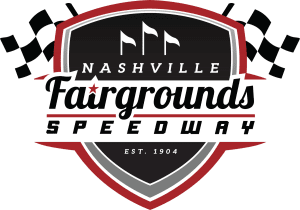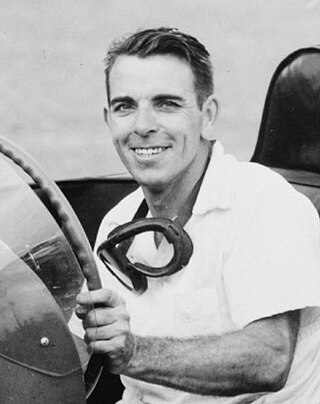
The United States Auto Club (USAC) is one of the sanctioning bodies of auto racing in the United States. From 1956 to 1979, USAC sanctioned the United States National Championship, and from 1956 to 1997 the organization sanctioned the Indianapolis 500. USAC serves as the sanctioning body for a number of racing series, including the Silver Crown Series, National Sprint Cars, National Midgets, Speed2 Midget Series, .25 Midget Series, Stadium Super Trucks, and Pirelli World Challenge. Seven-time USAC champion Levi Jones is USAC's Competition Director.

Paul Edward Goldsmith was an American racing driver. During his career he raced motorcycles, stock cars, and Indianapolis cars, achieving success in each discipline.
John Ashley Thomson was an American racecar driver. Thomson was nicknamed "the Flying Scot." He won several championships in midgets and sprint cars before competing in Championship Car racing. He won the pole position for the 1959 Indianapolis 500.
Alvah August “Al” Keller was an American racecar driver.

Nazareth Speedway is a defunct auto racing facility in Lower Nazareth Township in the Lehigh Valley region of eastern Pennsylvania, which operated from 1910 to 2004. The racing facility operated in two distinct course configurations. In its early years, it was a dirt twin oval layout. In 1987, it was reopened as a paved tri-oval that measured just slightly under 1 mile.

Langhorne Speedway was an automobile racetrack in Middletown Township, Bucks County, near the borough of Langhorne, Pennsylvania, a northern suburb of Philadelphia.

The 1949 NASCAR Strictly Stock season was the inaugural season of professional stock car racing in the United States. Beginning at Charlotte Speedway on June 19, 1949, the season included eight races and two exhibition races. The season concluded with the Wilkes 200 at North Wilkesboro Speedway on October 16. Raymond Parks won the Owners' Championship, while Red Byron won the Drivers' Championship with a 16th-place finish at the final race of the season.

Nashville Fairgrounds Speedway is a 6/10 mile motorsport racetrack located at the Nashville Fairgrounds near downtown Nashville, Tennessee. The track is the second-oldest continually operating track in the United States. The track held NASCAR Grand National/Winston Cup races from 1958 to 1984.
Robert Newman Flock was an American stock car racer. He qualified on the pole position for NASCAR's first Strictly Stock race and, along with Red Byron, is considered one of the two best drivers from that era. Flock died of a heart attack in 1964.

George Robson was an American racing driver. He is best known for winning the Indianapolis 500 in 1946. Although his earlier career had been unremarkable, Robson won several more races during the American Automobile Association (AAA) sanctioned 1946 Championship Car season, before being killed later that year in accident at Lakewood Speedway.
Illinois State Fairgrounds Racetrack is a one mile long clay oval motor racetrack on the Illinois State Fairgrounds in Springfield, the state capital. It is frequently nicknamed The Springfield Mile. Constructed in the late 19th century and reconstructed in 1927, the track has hosted competitive auto racing since 1910, making it one of the oldest speedways in the United States. The original mile track utilized the current frontstretch and the other side was behind the current grandstands and the straightaways were connected by tight turns. It is the oldest track to continually host national championship dirt track racing, holding its first national championship race in 1934 under the American Automobile Association banner. It is the home of five world records for automobile racing, making it one of the fastest dirt tracks in the world. Since 1993, the venue is managed by Bob Sargent's Track Enterprises.

Trenton Speedway was a racing facility located near Trenton, New Jersey at the New Jersey State Fairgrounds. Races for the United States' premier open-wheel and full-bodied racing series of the times were held at Trenton Speedway.
There has been auto racing in Illinois for almost as long as there have been automobiles. Almost every type of motorsport found in the United States can be found in Illinois. Both modern and historic tracks exist in Illinois, including NASCAR's Chicagoland Speedway and Gateway International Speedway. Notable drivers from Illinois include Danica Patrick, Tony Bettenhausen, and Fred Lorenzen.
Canfield Speedway is a half mile dirt oval racetrack that hosted (major) sanctioned auto racing from 1950 to 1964, but other associations ran until the late 1970s. There was also a 1/4 mile dirt racing surface that shared the front stretch with the 1/2 mile track. It was used until the track was closed to auto racing in 1973. Attendance varied from 30,000 people for larger events to 10,000 people for ones of less significance. The track is located at the Canfield Fairgrounds in Canfield, Ohio, and is still in use today, primarily during the Canfield Fair.

The USAC Stock Car division was the stock car racing class sanctioned by the United States Auto Club (USAC). The division raced nationally; drivers from USAC's open wheel classes like Indy cars, Silver Crown, sprints, and midgets frequently competed in races and won championships. Several NASCAR drivers raced in USAC Stock Cars at various points in their careers.
The 1946 AAA Championship Car season was the first season of American Championship car racing following World War II. After four years without automobile racing in the United States, the AAA Contest Board was initially concerned about having enough races, enough entrants, and suitable equipment, to contest season on such short notice for 1946. Even the Indianapolis 500 was in doubt, as the Indianapolis Motor Speedway had been fallen into a terrible state of neglect during the war years.
J. C. Hendrix was an American stock car racing driver. He competed in six NASCAR Grand National Series races from 1959 to 1961, recording two top-ten finishes.
The 1956 NASCAR Grand National Season began on November 13, 1955, and ended on November 18, 1956, lasting slightly longer than a full year.
Frank Luptow (1914-1952) was an American racing driver. He competed in International Motor Contest Association (IMCA) big cars and NASCAR stock cars. He won the 1949, 1950, and 1951 IMCA big car championships.

Dave Watson is an American racing driver from Milton, Wisconsin. Watson was the 1977 USAC Stock Car Rookie of the Year. He raced five NASCAR Winston Cup races with one Top 10. Watson won in the Sports Car Club of America (SCCA), Grand American and IMSA.










